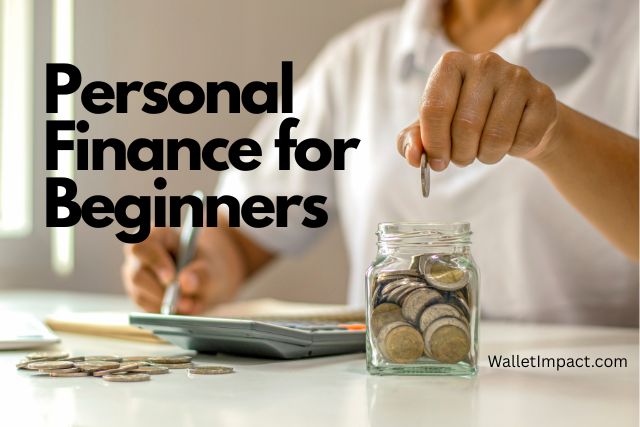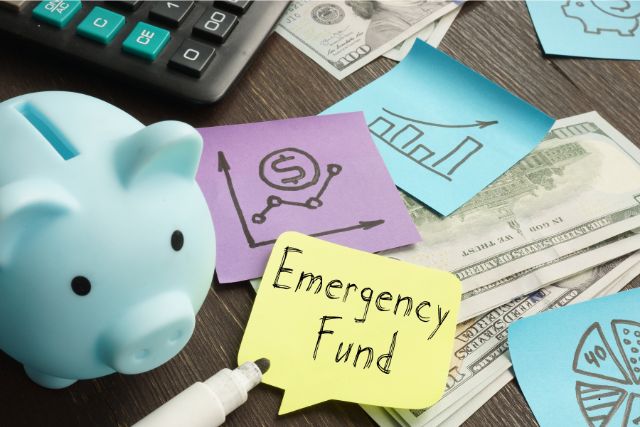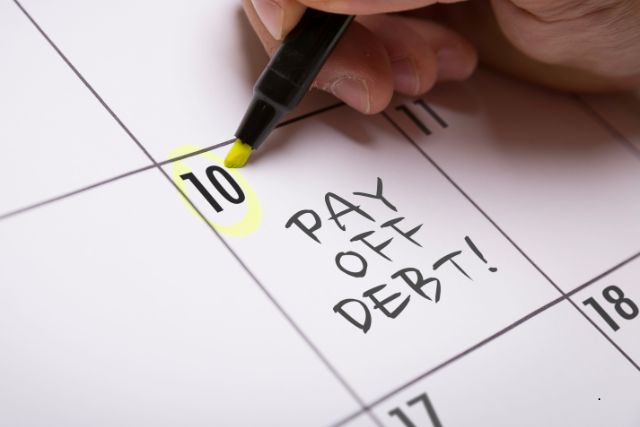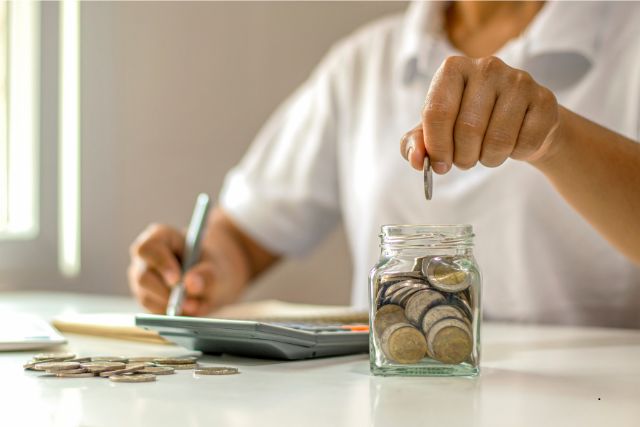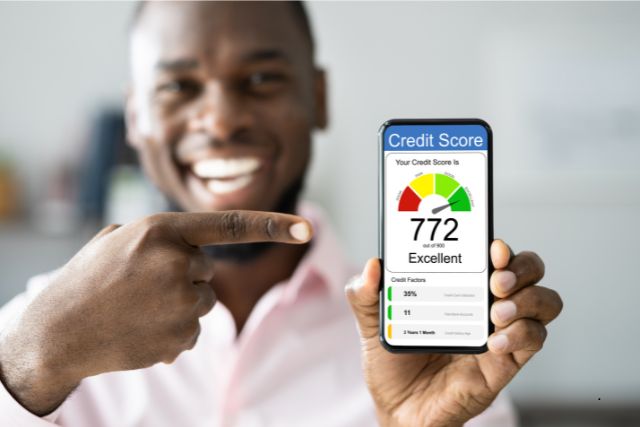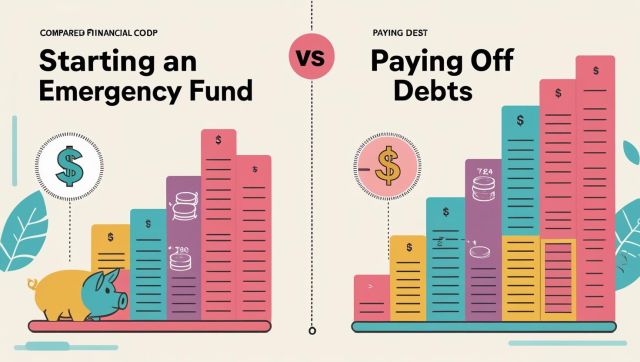Personal Finance for Beginners: Complete Guide to Managing Money
Did you know that 75% of Americans live paycheck to paycheck, regardless of their income level? That’s a staggering statistic that highlights the crucial importance of financial literacy in today’s world. If you’re feeling overwhelmed by terms like “compound interest,” “401(k),” or “emergency fund,” you’re not alone.
Managing money doesn’t have to be rocket science, though. I’ve been there, staring at my bank account, wondering where all my money went, feeling anxious about bills, and avoiding those scary financial conversations. But here’s the thing: taking control of your finances is one of the most empowering things you can do for your future self!
In this comprehensive guide, we’ll break down everything you need to know about personal finance into bite-sized, actionable steps. From creating your first budget to understanding investments, we’ll cover it all without the confusing jargon. Ready to transform your financial life? Let’s dive in!
1. Understanding Your Financial Foundation
Let me tell you about the day I finally decided to calculate my net worth. I was sitting at my kitchen table with a stack of bills, feeling completely overwhelmed and honestly a little scared. My credit card statement showed $10,000, and I had maybe $1500 in my checking account. Not exactly the financial picture I wanted to see at 32 years old.
But here’s the thing – that moment of facing the numbers head-on was actually the turning point in my entire financial journey. Because you can’t fix what you don’t measure, right?
Calculating Your Net Worth (And Why It’s Not as Scary as You Think)
Your net worth is everything you own minus everything you owe. Assets minus liabilities equals net worth – it’s that simple. When I first calculated mine, I got $34,600. Nothing to write home about, but it’s a starting point.
But you know what? That number became my baseline. Every three months, I’d recalculate it, and watching it slowly climb was incredibly motivating.
Here’s exactly how to calculate yours:
Assets (what you own):
- Checking and savings account balances
- Investment accounts (401k, IRA, brokerage)
- Cash value of life insurance
- Real estate value (your home if you own one)
- Vehicle values (use Kelley Blue Book)
- Personal property (jewelry, electronics – be realistic here)
Liabilities (what you owe):
- Credit card balances
- Student loans
- Mortgage balance
- Car loans
- Personal loans
- Any money borrowed from family
I currently use a simple spreadsheet, but honestly, apps like Every Dollar can automate this process by connecting to your accounts. Game changer.
Getting Real About Your Income and Expenses
This part was humbling. I thought I knew where my money was going until I tracked every single dollar for a month. Turns out, I was spending close to $500 on dining out. Five hundred dollars! That’s over $6000 a year on eating out.
Income sources to track:
- Your salary (after taxes – use your actual take-home)
- Side hustle income
- Investment dividends
- Rental income
- Any other regular money coming in
Expense categories that matter:
- Housing (rent/mortgage, utilities, maintenance)
- Transportation (car payment, gas, insurance, maintenance)
- Food (groceries AND dining out – track separately)
- Insurance (health, life, disability)
- Debt payments
- Entertainment and subscriptions
- Personal care
- Miscellaneous (this category should be small!)
The key is being brutally honest. Don’t put down what you think you should spend on groceries – put down what you actually spend.
Assets vs. Liabilities: The Game-Changer Concept
This is where things clicked for me. An asset puts money in your pocket. A liability takes money out of your pocket. Sounds obvious, but it’s not always clear-cut.
Your primary residence? It’s not really an asset until you sell it, despite what people say. It costs you money every month in mortgage payments, taxes, insurance, and maintenance. I learned this the hard way when I bought a house I couldn’t really afford because “it’s an investment.”
Real assets include:
- Stocks and bonds that pay dividends
- Rental properties that generate positive cash flow
- Business investments that provide income
- High-yield savings accounts (okay, tiny returns, but still positive)
Understanding this difference completely changed how I looked at purchases. Before buying anything expensive, I ask myself: “Is this going to make me money or cost me money over time?”
Setting Goals That Actually Work
Here’s where I messed up for years – I set these massive, vague goals like “get rich” or “save more money.” Totally useless.
Short-term goals (1-2 years):
- Build a $1,000 emergency fund
- Pay off specific credit card debt
- Save for a vacation or car down payment
- Increase credit score by 50 points
Long-term goals (5+ years):
- Buy a house
- Save six months of expenses
- Max out retirement contributions
- Build an investment portfolio to $100,000
The magic happens when you connect short-term actions to long-term dreams. My $1,000 emergency fund goal supported my long-term goal of financial stability. Every small win built momentum.
Your Financial Mission Statement
This might sound cheesy, but creating a personal financial mission statement was actually really helpful.
Mine is simple: “I manage money intentionally to create security for my family and freedom to pursue meaningful experiences.”
When I’m tempted to make an impulse purchase or skip saving for a month, I think about that statement. Does this decision align with creating security and freedom? Usually, the answer guides me pretty clearly.
Your mission statement should reflect your values and what financial success means to you personally. Maybe it’s early retirement, maybe it’s funding your kids’ education, maybe it’s starting a business. Whatever it is, write it down and refer back to it when money decisions get tough.
The foundation matters more than anything else you’ll do with money. Get this part right, and everything else becomes so much easier to figure out.
2. Budgeting Basics That Actually Work
I’ll be honest with you – I failed at budgeting approximately seventeen times before I found something that actually stuck. My first attempt was this elaborate Excel spreadsheet with 47 different categories and color coding that would make a rainbow jealous. It lasted exactly three days before I gave up in frustration.
The problem wasn’t that budgeting doesn’t work. The problem was I was making it way more complicated than it needed to be. Once I simplified things and found the right method for my personality, everything changed. Now I actually look forward to budget meetings with myself (yes, I schedule them like real appointments).
The 50/30/20 Rule: Your Budget Training Wheels
This is where I tell everyone to start, especially if the word “budget” makes you want to hide under a blanket. The 50/30/20 rule is beautifully simple: 50% of your after-tax income goes to needs, 30% to wants, and 20% to savings and debt payoff.
Let’s say you bring home $4,000 a month after taxes. Here’s how it breaks down:
- $2,000 for needs: Rent, utilities, groceries, minimum debt payments, insurance
- $1,200 for wants: Dining out, entertainment, hobbies, shopping, subscriptions
- $800 for savings/extra debt payments: Emergency fund, retirement, paying extra on loans
It’s not perfect – some people need more than 50% for basic expenses, especially in expensive cities – but it gives you a framework to work with.
The beauty of this system? You don’t have to track every single dollar. As long as you’re hitting those three big buckets, you’re golden.
Zero-Based Budgeting: When You Want Total Control
Once I got comfortable with basic budgeting, I graduated to zero-based budgeting. This is where every dollar has a job before the month starts. Income minus expenses equals zero – hence the name.
Here’s how it works: Before the month begins, I assign every dollar I expect to earn to a specific category. Rent gets $1,200, groceries get $400, gas gets $150, and so on. Whatever’s left over gets assigned to savings or debt payoff.
The first time I tried this, it took me three hours to plan one month. Now? Twenty minutes, tops.
My zero-based budget categories:
- Fixed expenses (rent, insurance, minimum debt payments)
- Variable necessities (groceries, gas, utilities)
- Discretionary spending (entertainment, dining out)
- Savings goals (emergency fund, vacation fund)
- Debt elimination (extra payments)
The psychological benefit is huge. When you’ve already decided where every dollar goes, there’s no guilt about spending money on things you’ve budgeted for. Want to spend $100 on dinner? Cool, as long as it fits in your dining out category.
The Envelope Method: Old School but Effective
The envelope method forces you to spend only what you have – because when the envelope is empty, you’re done spending in that category.
I tried the physical cash version for a few months. It was enlightening but kind of a pain in our mostly cashless world. So I adapted it using multiple checking accounts instead.
My “digital envelope” system:
- Main checking for fixed bills
- “Groceries” account gets $400 transferred each month
- “Fun money” account gets $300
- “Gas” account gets $200
When the fun money account hits zero, no more restaurants or movies until next month. It sounds restrictive, but it’s actually liberating. No more wondering if I can afford something – I just check the account balance.
YNAB (You Need A Budget) software essentially digitizes this concept, and a lot of people swear by it.
Apps and Tools That Don’t Suck
I’ve tried probably fifteen different budgeting apps. Most of them are either too complicated or too simple. Here are the ones that actually work:
Credit Karma: Free and connects to all your accounts automatically. Great for tracking where your money went, but not as good for planning where it should go.
YNAB: Costs $14/month but worth every penny if you like the envelope method. Has a learning curve, but their free workshops are actually helpful.
EveryDollar: Dave Ramsey’s app. Simple zero-based budgeting. Free version works fine, paid version connects to your accounts.
PocketGuard: Shows you how much “pocket money” you have after bills and goals. Good for people who want simple.
Spreadsheets: Don’t sleep on Google Sheets or Excel. Sometimes, simple is better, and you can customize everything.
Mistakes I Made (So You Don’t Have To)
Setting unrealistic grocery budgets: I tried to spend $200/month on food for two adults. We lasted twelve days before hitting up the drive-through. Be realistic about your spending patterns.
Not planning for irregular expenses: Car registration, oil changes, birthday gifts – these aren’t monthly expenses, but they happen. I now budget $100/month for “misc stuff that comes up.”
Being too rigid: My first budget had no flexibility. When I went $20 over on gas, I felt like a failure and quit tracking altogether. Build in buffer room.
Forgetting about subscription services: Those $9.99 charges add up fast. I was spending $50/month on various subscriptions I barely used.
When Life Happens to Your Budget
Your budget isn’t a prison sentence – it’s a living document. Last year, my car needed an $850 repair. Did that blow my budget? Absolutely. Did I abandon budgeting forever? Nope.
I adjusted. Paused my vacation fund contributions for three months to rebuild my emergency fund. Cut dining out in half for a couple months. The key is adapting, not giving up.
Budget adjustment strategies:
- Review and revise monthly, not daily
- Have a “miscellaneous” category for unexpected stuff
- Don’t beat yourself up over going over occasionally
- Focus on the big picture trends, not daily perfection
The best budget is the one you’ll actually use consistently. Start simple, find what works for your personality, and remember – it’s supposed to make your life easier, not more stressful.
3. Building Your Emergency Fund (Your Financial Safety Net)
Picture this: It’s a Tuesday morning in February, you’re going through the McDonalds drive through and your car stops moving, you realize it needs a new transmission. A $4000 repair bill.
Two years earlier, this would’ve sent me into a complete panic. I would’ve put it on a credit card, stressed about the payments for months, and probably eaten ramen for weeks trying to make ends meet. But this time? I walked to my laptop, transferred money from my emergency fund, and called the mechanic. Done. The relief I felt in that moment was worth every dollar I’d saved.
That’s the power of an emergency fund, folks. It’s not just money sitting in an account – it’s peace of mind you can sleep on.
Why Your Emergency Fund Comes First (Yes, Even Before Investing)
I know, I know. Everyone on social media is talking about investing and crypto and getting rich quick. But here’s the thing – you can’t build wealth on a shaky foundation. And trust me, I learned this lesson the expensive way.
Back when I first started getting serious about money, I was so excited about compound interest that I threw every extra dollar at my retirement plan. Felt pretty smart until my car died, I needed to repair my shower, and my furnace went out all in the same month. Guess what I had to do? Yep, rack up credit card debt.
An emergency fund is your financial shock absorber. Without it, every unexpected expense becomes a crisis that derails your entire financial plan. Life’s gonna throw curveballs – the question is whether you’ll be ready to catch them or get smacked in the face.
Why an emergency fund beats paying off debt first:
- Prevents you from going deeper into debt when emergencies hit
- Gives you confidence to tackle debt payments more aggressively
- Reduces financial stress and anxiety significantly
- Protects your other financial goals from disruption
Start with $1,000 if you’re paying off debt, then build to full emergency fund after you’re debt-free (except mortgage). This mini emergency fund covers most small crises without derailing your debt snowball.
The 3-6 Months Rule: What It Really Means
Everyone says “save 3-6 months of expenses,” but nobody explains what expenses they’re talking about. When I first heard this, I calculated my full monthly spending – including dining out, entertainment, everything. Turns out, you don’t need money for restaurants and concerts during a real emergency.
Your emergency fund should cover survival expenses only:
- Housing (rent/mortgage, utilities)
- Food (groceries, not takeout)
- Transportation (car payment, gas, insurance)
- Insurance premiums
- Minimum debt payments
- Basic phone plan
- Essential medications
For me, this comes to about $2,800 per month versus my normal $4,200 in total spending. Big difference, right?
How to decide between 3 or 6 months:
- 3 months: Stable job, dual income household, good health insurance
- 6 months: Self-employed, single income, work in volatile industry, health issues
- More than 6 months: If it helps you sleep better and you’ve got other goals handled
I keep 6 months saved because I’m self-employed and anxiety-prone. Figure out what makes sense for your situation.
Where to Actually Keep This Money
This was another thing I got wrong initially. I kept my emergency fund in a regular savings account earning 0.01% interest. Basically paying the bank to hold my money. Then I overcorrected and put it in index funds because “it should be growing!”
Wrong move. Remember the laptop/dog/AC month? Yeah, the market was down 15% right when I needed the money. Oops.
Best places for emergency funds:
- High-yield savings accounts: 4-5% interest currently, FDIC insured, accessible within days
- Money market accounts: Similar rates, sometimes come with check-writing
- CDs (maybe): Only if you ladder them and can access portions when needed
Where NOT to keep emergency funds:
- Regular savings accounts earn nothing
- Checking accounts (too easy to accidentally spend)
- Investment accounts (market risk defeats the purpose)
- Under your mattress (seriously, some people do this)
I PayPal Savings right now. Currently earning 3.8% APY, and I can transfer money to my checking account within 2-3 business days.
Creative Ways to Build Your Fund Faster
Building an emergency fund feels like watching paint dry, especially when you’re starting from zero. I tried the “just save more” approach for about six months and got nowhere. Then I got creative.
My emergency fund building hacks:
The $5 bill trick: Every time you get a $5 bill as change, put it straight into a jar. Sounds silly, but I collected $840 in over a year just from this.
Sell stuff you don’t use: I went through my apartment like a tornado and sold everything I hadn’t touched in a year. Old textbooks, clothes that didn’t fit, kitchen gadgets I used once. You can sell them on Facebook Marketplace or Craigslist.
Direct deposit split: Had my payroll department send $20 a week from each paycheck directly to my emergency fund account. Never saw the money, didn’t miss it, and it saves me an easy $1000 per year.
Side hustle windfall: I’ve started several websites over the years and earn a modest $1000 per month from them.
Tax refund: Instead of blowing my $1,100 tax refund on vacation, it went straight to emergency savings. Boring but effective.
Automate the pennies: Rounded up every purchase to the nearest dollar and saved the change. Apps like Acorns do this automatically.
The key is making it as automatic as possible. Willpower fades, but systems work forever.
When to Use It (And When You’re Just Making Excuses)
This is where people get tricky with themselves. I’ve seen friends raid their emergency funds for vacations, new phones, and “investment opportunities.” That’s not what this money is for, people!
Legitimate emergency fund uses:
- Job loss or significant income reduction
- Major medical expenses not covered by insurance
- Essential home repairs (furnace dies, roof leaks, plumbing disaster)
- Car repairs needed to get to work
- Emergency travel for family situations
NOT emergencies:
- Christmas gifts (happens every December, plan for it)
- Vacation you really want to take
- Sale on something you’ve been wanting
- Car repairs for convenience (like upgrading your stereo)
- Investing opportunity you don’t want to miss
When I used mine for the transmission, I felt a tiny bit guilty. But then I remembered what happened before I had it – months of credit card payments and stress. The fund did exactly what it was supposed to do.
Emergency fund replacement strategy: When you do use it, pause other financial goals temporarily and rebuild the fund as quickly as possible. I replaced my transmission money within three months by temporarily stopping my Roth IRA contributions and eating out less.
Your emergency fund isn’t an investment. It’s not supposed to make you rich. It’s insurance against life’s inevitable surprises, and honestly, it’s the most important financial move you’ll ever make. Everything else gets easier once you know you can handle whatever gets thrown at you.
4. Conquering Debt Once and For All
I still remember the exact moment I realized I was drowning in debt. I was was at a gas station trying to buy fuel. Then my first credit card got declined. This was a wake up call.
That night, I wrote down every single debt I had on a piece of paper. Credit cards, student loans, car loans, and what I had saved. The total? $10,000 I made $50,000 a year. The math was not mathing, as the kids say.
But here’s the thing about debt – it feels impossible until suddenly it doesn’t. It took me three years, but I paid off every penny of that debt (except my mortgage). And if my financially clueless former self could do it, so can you.
Good Debt vs Bad Debt: It’s Not All Created Equal
This was the first thing I had to wrap my head around. Not all debt is evil, which was honestly a relief because I felt like a complete failure for having any at all.
Good debt (debt that can make you money or improve your financial position):
- Mortgage on your primary residence
- Student loans that increase your earning potential
- Business loans that generate income
- Real estate investment loans with positive cash flow
Bad debt (debt that costs you money and doesn’t improve your financial situation):
- Credit card debt from lifestyle spending
- Car loans (cars depreciate rapidly)
- Personal loans for vacations or luxury items
- Payday loans (seriously, avoid these at all costs)
My student loans? Annoying but manageable – they helped me get a better job. My credit card debt from eating out and shopping? That was the real problem. Once I understood this distinction, I could prioritize which debts to attack first.
Here’s what shocked me: the average American has $6,371 in credit card debt. I had $10,000 of debt. Knowing I wasn’t alone somehow made it feel less shameful and more like a problem I could solve.
Debt Snowball vs Debt Avalanche: The Great Debate
Everyone’s got an opinion on this, and honestly, I tried both methods before finding what worked for me.
Debt Avalanche Method: List debts by interest rate, highest to lowest. Pay minimums on everything, throw extra money at the highest interest rate debt first. Mathematically, this saves the most money.
My debt avalanche list looked like this:
- Credit Card #1: $4,200 at 24.99% APR
- Credit Card #2: $3,800 at 19.99% APR
- Car loan: $8,900 at 6.5% APR
- Credit Card #3: $4,400 at 5.99% APR (promotional rate)
- Student loan: $25,000 at 4.2% APR
I tried this method for four months and made progress, but it felt slow and discouraging. Paying off that first credit card took forever because it had the biggest balance.
Debt Snowball Method: List debts by balance, smallest to largest. Pay minimums on everything, and attack the smallest balance first, regardless of interest rate. It’s about momentum and psychology.
My snowball list:
- Credit Card #2: $3,800
- Credit Card #1: $4,200
- Credit Card #3: $4,400
- Car loan: $8,900
This method changed everything for me. Paying off that first card in two months gave me such a rush of accomplishment that I became obsessed with finding extra money to throw at debt. The momentum was addictive.
Which should you choose? If you’re super disciplined and motivated by saving money, go avalanche. If you need quick wins to stay motivated (like me), go snowball. The best method is the one you’ll actually stick with.
Try This Tool: Here is a free spreadsheet that gives you the option to try both options the debt snowball or the debt avalanche. You can try both options and see which will save you the most money and payoff your debts faster.
Negotiating with Creditors: Scarier Than It Sounds
I avoided calling my credit card companies for months because I was embarrassed and didn’t think they’d help. Turns out, they want to get paid and are often willing to work with you.
Negotiation Options:
- Get the interest rate reduced.
- Negotiated a payment plan for medical bills
- Got late fees waived by explaining my situation honestly
All you have to do is ask. The worst they could tell you is no.
Script that worked for me: “Hi, I’m calling because I’m working hard to pay off my debt, and I’m wondering if there are any programs or options that might help me pay this off faster. I’ve been a customer for X years, and I want to do right by this debt.”
What they might offer:
- Temporary interest rate reduction
- Payment plan with lower monthly amounts
- Settlement offer (if you’re really behind)
- Hardship programs during job loss or medical issues
Important: Get everything in writing before you agree to anything. And never agree to something you can’t actually afford just to get them off the phone.
Credit Cards: From Enemy to Tool
I used to think credit cards were inherently evil. Now I realize they’re just tools – dangerous in the wrong hands, useful when handled properly.
How I use credit cards now (after paying them off):
- Pay for everything with rewards cards
- Pay off the full balance every single month
- Never spend money I don’t already have
- Take advantage of signup bonuses for planned expenses
- Use them to build a credit history
Credit card rules that keep me out of trouble:
- If I can’t afford it with cash, I can’t afford it with credit
- Check balances weekly, not monthly
- Set up automatic payments for full statement balance
- Keep utilization under 10% of credit limits
- Don’t close old cards (hurts credit score)
The key shift was changing from “I’ll pay this off eventually” to “I’m borrowing this money for 3 weeks until my statement posts.” Completely different mindset.
Student Loans: The Marathon Debt
Student loans are often the biggest debt people have, and they stick around forever (seriously, they survive bankruptcy).
Repayment options I wish I’d known about sooner:
- Income-driven repayment plans: Payments based on your income, not loan balance
- Public Service Loan Forgiveness: Forgiveness after 10 years of qualifying payments
- Employer assistance programs: Some companies help with student loan payments
- Tax benefits: Student loan interest deduction up to $2,500 per year
Simple student loan strategy: Keep making minimum payments while attacking credit card debt first (higher interest rates). Once the credit cards were gone, throw that extra payment money at student loans. You’ll pay them off early and save thousands on interest
Refinancing considerations: Look into refinancing but but remember you will lose federal protections like income-driven repayment and potential forgiveness programs. If you have private loans already, refinancing might save you money with better rates.
When Debt Consolidation Makes Sense (And When It Doesn’t)
I almost made a huge mistake here. Got pre-approved for a debt consolidation loan that would’ve combined all my credit card debt into one payment at a lower interest rate. Sounded perfect, right?
Here’s what saved me: I ran the numbers and realized that even with the lower interest rate, the longer repayment term meant I’d pay more in total interest. Plus, I knew myself – if I consolidated the debt and freed up my credit cards, I’d probably just rack up more debt.
Debt consolidation might work if:
- You have good credit and can get a significantly lower interest rate
- You’re disciplined enough not to run up new debt
- The math actually saves you money over the life of the loans
- You’re struggling to keep track of multiple payments
Red flags:
- Companies that charge upfront fees
- Promises to “eliminate” your debt without payment
- Pressure to decide immediately
- Requirements to stop paying your current debts
Better alternatives I found:
- Balance transfer cards with 0% intro APR (paid off during promo period)
- Personal loans from credit unions (much better rates than online lenders)
- Just buckling down and paying off debt faster with the snowball method
The truth about debt consolidation? It treats the symptom, not the disease. If you don’t change the spending habits that got you into debt, you’ll just end up with more debt than before.
My debt freedom timeline:
- Month 1-3: Built mini emergency fund, got organized
- Month 4-18: Paid off credit cards using debt snowball
- Month 19-30: Attacked car loan aggressively
Three years felt like forever when I started, but looking back, it went by pretty fast. And the feeling of making that final payment? Absolutely priceless. Now instead of sending $980 a month to creditors, I invest that money. Compound interest working for me instead of against me – what a concept.
5. Saving Money Like a Pro
For years, I was the king of good intentions when it came to saving money. I’d promise myself I’d save whatever was “left over” at the end of each month.
Spoiler alert: there was never anything left over. I’d find myself on day 28 of the month with $200 in my checking account, wondering where the heck my money went.
Then I discovered something that changed everything: you don’t save what’s left after spending, you spend what’s left after saving. Sounds simple, but it took me way too long to figure this out. Once I started treating savings like a non-negotiable bill I had to pay, everything shifted.
Now I save 25% of my income without even thinking about it. Not because I became some financial genius overnight, but because I finally learned to work with my lazy tendencies instead of against them.
Automatic Savings: Set It and Forget It
The biggest breakthrough in my saving journey was realizing I couldn’t trust myself to manually transfer money to savings every month. I’d always find an excuse – unexpected expense, special occasion, or just plain forgetfulness.
My automatic savings setup:
- Direct deposit split: $200 per week of my paycheck goes straight to savings, never touches checking
- Round-up apps: Every purchase gets rounded up to the nearest dollar, change goes to savings.
- Automatic transfers: $200 moves from checking to savings every payday
- Tax refund redirect: Set up direct deposit to savings account for next year’s refund
The key is making it invisible. I calculated my take-home pay after automatic savings and budgeted based on that number. You can’t spend money you never see.
Apps that make this easier:
- Qapital: Rounds up purchases and saves the change
- Digit: Analyzes your spending and saves small amounts you won’t miss
- Acorns: Invests your spare change (though I prefer keeping savings separate from investing)
I started with just $20 per week automatically transferred. Didn’t even notice it was gone, but it added up to $1000 by the end of the year. Then I bumped it up gradually as I got more comfortable.
Pro tip: Time your automatic transfers for right after payday. That way you’re not accidentally spending the money you meant to save.
High-Yield Savings vs Traditional Savings: The Difference Is Real
I kept my savings in a regular bank account for three years. Three years! I was earning maybe $2 per year in interest on thousands of dollars. Meanwhile, my money was basically losing value to inflation.
Traditional savings account reality check:
- Average interest rate: 0.01% to 0.05%
- My old bank paid 0.01% APY
- On $5,000 saved, I earned about $0.50 per year
- Inflation was eating my purchasing power
High-yield savings accounts changed the game:
- Current rates: 4.0% to 5.0% APY
- My PayPal Savings account pays 3.8% APY
- On $5,000 saved, I now earn about $190 per year
- That’s a $140+ difference annually
Top high-yield savings options I’ve used:
- PayPal Savings: 3.80% APY, no minimums, easy transfers
- Marcus by Goldman Sachs: 3.65% APY, no minimums, easy transfers
- Ally Bank: 3.6% APY, great customer service, mobile app
- Capital One 360: 3.6% APY, multiple savings goals feature
- American Express Personal Savings: 3.6% APY, solid reputation
The only downside? Usually takes 2-3 business days to transfer money to your checking account. But honestly, that’s a feature, not a bug – it prevents impulse spending of your savings.
Warning about rate chasing: Don’t constantly move your money chasing the highest rate. Pick a reputable bank with consistently competitive rates and stick with it. The difference between 3.8% and 3.6% isn’t worth the hassle of switching banks every few months.
Sinking Funds: The Game-Changer Nobody Talks About
This concept completely revolutionized how I handle irregular expenses. Instead of being blindsided by Christmas gifts, car registration, or annual insurance premiums, I save for them throughout the year.
Sinking fund categories:
- Car maintenance: $75/month (oil changes, tires, repairs)
- Christmas gifts: $50/month (saves $600 for the holidays)
- Home maintenance: $100/month (appliances break, stuff needs fixing)
- Vacation fund: $150/month (guilt-free travel money)
- Medical expenses: $40/month (covers my insurance deductible)
- Professional development: $25/month (courses, conferences, books)
Use separate high-yield savings accounts for each category. Some banks let you create multiple savings goals within one account, which works great too.
How to calculate sinking fund amounts:
- List all your irregular expenses from last year
- Add up the total (mine was $4,200)
- Divide by 12 months ($350/month)
- Set up automatic transfers for that amount
The first year feels like you’re saving for nothing, but year two? Pure magic. When my car needed new brakes ($480), I just transferred money from my car maintenance fund. No stress, no credit card debt, no financial crisis.
Money-Saving Hacks That Actually Work
I’ve tried every money-saving trick on the internet. Most of them are either too time-consuming or save you pennies. Here are the ones that actually moved the needle for me:
Grocery shopping hacks:
- Shop with a list and stick to it: Saves me about $30 per trip
- Generic brands for basics: Cleaning supplies, medicine, pasta – saves 30-50%
- Meal planning: Prevents food waste and impulse purchases
- Shop the perimeter first: Fresh foods are usually cheaper and healthier
Utility bill reductions:
- Programmable thermostat: Saves $15-20/month on heating and cooling
- LED bulbs: Upfront cost but last forever and use 75% less energy
- Unplug devices: That cable box uses power even when “off”
- Annual rate shopping: Spent 2 hours comparing electricity rates, saved $240/year
- Subscription audit: I discovered I was paying for $127/month in subscriptions I barely used. Cancelled everything except Netflix. That’s $1,080 back in my pocket annually.
- Split the bill: Cancel your expensive cable TV and get a subscription like FUBO and split it with a friend or family member. This saves me $225 a month right there.
Transportation savings:
- Combine errands: One trip instead of three saves gas and time
- Costco gas: Usually 10-15 cents cheaper per gallon
- Maintenance schedule: Regular oil changes prevent expensive repairs
- Walk/bike short trips: Saves gas and gives you exercise
The 24-hour rule: For any non-essential purchase over $50, I wait 24 hours. About 60% of the time, I realize I don’t actually need it.
Seasonal Saving Opportunities
I used to think sales were just marketing tricks, but there are genuine seasonal patterns that can save you serious money if you time things right.
January-February:
- Gym equipment: Everyone’s selling their unused Christmas presents
- Winter clothes: End-of-season clearance up to 70% off
- Mattresses: New Year sales are real, saved $400 on mine
March-April:
- Spring cleaning supplies: Stock up before peak cleaning season
- Tax prep software: Often discounted after tax season starts
May-June:
- Appliances: Memorial Day sales, new models coming out
- Outdoor furniture: Before peak summer demand
July-August:
- Back-to-school supplies: Even if you don’t have kids, office supplies are cheap
- Summer clothes: End-of-season clearance time
September-October:
- Cars: New model year means deals on current year inventory
- Tools: Pre-holiday sales for gift-giving season
November-December:
- Black Friday/Cyber Monday: Plan ahead for things you actually need
- Holiday decorations: Buy next year’s stuff at 75% off after Christmas
My seasonal savings strategy: I keep a running list throughout the year of things I need but don’t need immediately. Then I time my purchases around these seasonal patterns. Saved over $800 last year just by being patient and strategic.
The danger of seasonal sales: Only buy things you were already planning to purchase. A 50% off sale on something you don’t need is still 100% waste of money.
Year-round savings calendar I follow:
- January: Set up automatic savings increases
- April: Review and negotiate insurance rates
- July: Plan holiday spending and start saving
- October: Audit subscriptions and recurring expenses
The key to saving money isn’t depriving yourself of everything you enjoy. It’s being intentional about your spending and making your money work as hard as you do. Start with one or two strategies that feel manageable, and add more as they become habits.
Most importantly, remember that small amounts add up to big results over time. That $200/month in automatic savings? It becomes $2,400 by year-end, plus interest. Those little changes compound into financial freedom faster than you’d think.
6. Credit Scores Demystified
Look, I’ll be honest with you – credit scores used to completely baffle me. Like, seriously baffles me. Thankfully, I had some great parents who helped me out in the beginning by cosigning on my first car loan.
At the time, I didn’t realize how much this was helping me out, but just the simple act of taking out a small car loan and paying it off over the next 3 years helped me jump-start my credit.
Let’s face it, your credit score determines whether you can buy a house, get a decent car loan, or even rent an apartment in some places. So you need to pay attention to it.
What Your Credit Score Actually Is (And Why It Controls Your Life)
Your credit score is essentially a three-digit number between 300 and 850 that tells lenders how likely you are to pay back money you borrow. Think of it as your financial report card that follows you everywhere.
The most common scoring model is FICO, which about 90% of lenders use. There’s also VantageScore, but FICO is the big kahuna. Here’s the breakdown that took me forever to memorize:
- 800-850: Excellent (you’re basically a financial rockstar)
- 740-799: Very Good
- 670-739: Good
- 580-669: Fair (this is where I was stuck for way too long)
- 300-579: Poor
I learned the hard way that anything below 620 makes life pretty expensive. In some cases, you may get approved for a loan, but be prepared to pay high interest rates.
The Five Factors That Make or Break Your Score
This part really frustrated me initially because nobody explained it clearly. Your credit score gets calculated using five main factors, and understanding these percentages changed everything for me:
Payment History (35%): This is the big one. Late payments will absolutely tank your score. I missed one credit card payment by three days back in 2019, and my score dropped 23 points. Just from being three days late!
Credit Utilization (30%): This one’s tricky. It’s how much credit you’re using compared to your total available credit. The magic number is keeping it under 30%, but honestly, under 10% is even better. I used to max out my $1,000 credit card every month and couldn’t figure out why my score sucked.
Length of Credit History (15%): Basically, how long you’ve had credit accounts open. This is why financial experts always say don’t close your oldest credit card, even if you’re not using it.
Credit Mix (10%): Having different types of credit – credit cards, auto loans, mortgages. Though, don’t go crazy opening accounts just for this.
New Credit (10%): Too many hard inquiries in a short time frame will ding your score. So don’t apply for five different credit cards in one month. Stupid move.
How to Check Your Credit Report Without Getting Scammed
Here’s something that’ll save you money – you can check your credit report for free. Legally free. The government mandates that you get one free report from each of the three major credit bureaus (Experian, Equifax, and TransUnion) every year.
Go to annualcreditreport.com – that’s the official site. Don’t fall for those “free credit report” commercials that sign you up for monthly services. Been there, got charged $29.95 a month for something I could get free.
I check mine every four months, rotating between the three bureaus. So January I’ll check Experian, May I’ll check Equifax, September I’ll check TransUnion. Gives me year-round monitoring without paying anything.
For your actual credit score (not just the report), Credit Karma and many banks offer free FICO scores now. My Chase card shows my score right in their app.
My Step-by-Step Credit Improvement Strategy
If your credit score is low, here’s exactly how to fix it.
Step 1: Pay down your credit card balances to under 10% utilization. This single move could bump up your score 50 points
Step 2: Set up automatic payments for at least the minimum on everything. I use my phone’s calendar to remind me three days before each due date.
Step 3: Disputed errors on my credit report. These may be anything from old medical bills to things you didn’t even know about.
Step 4: Become an authorized user on someone else’s credit card. If you know someone who has great credit, you can get listed on their card as an authorized user to improve your score. You don’t need to use the account.
Step 5: Get a secured credit card to build a more positive payment history. Put down a $500 deposit and used it for gas only, paying it off completely every month.
The biggest mistake I made was trying to do everything at once. Credit improvement requires patience, which, honestly, drove me nuts at first.
Credit Building for Complete Beginners
If you’re starting from zero credit (not bad credit, just no credit), here’s what I wish someone had told me:
Start with a secured credit card or see if you can become an authorized user on a family member’s account. Student credit cards are also good options if you’re in school.
Use the card for small, regular purchases, such as Netflix or Spotify. Set up autopay for the full balance. Never, ever carry a balance if you can help it.
After six months of on-time payments, your credit score should start appearing. Most people see their first score around 650-680 if they’re doing everything right.
Myths That Cost Me Time and Money
The internet is full of terrible credit advice. Here are the myths I believed that hurt my progress:
Myth: Carrying a small balance helps your score. Nope. Pay that sucker off completely every month.
Myth: Checking your credit hurts your score. Only hard inquiries (when you apply for credit) hurt your score. Checking your own score is a soft inquiry and doesn’t affect anything.
Myth: You need to pay for credit monitoring. Most banks and credit cards offer free monitoring now. Instead put a freeze on your credit to prevent scammers from taking out credit in your name. Here is a great guide to help you get started.
Myth: Closing old credit cards helps your score. Usually makes it worse by reducing your available credit and average account age.
The truth is, improving your credit score isn’t rocket science, but it does require consistency and patience. After bumping my score to 810 I can tell you the peace of mind is worth every bit of effort it took to get there.
7. Investing 101: Growing Your Wealth
Man, I wish someone had sat me down early in my life and explained investing like I’m about to explain it to you. I spent way too many years thinking my savings account earning 0.05% interest was actually doing something for my future. Spoiler alert: it wasn’t.
The wake-up call came when I calculated that my $20,000 sitting in savings for three years had earned me a whopping $15 in interest. Meanwhile, inflation was eating away at my purchasing power faster than I could say “compound interest.” That’s when I finally decided to stop being scared of the stock market and actually learn something.
Why Your Savings Account Is Basically Losing You Money
Here’s the brutal truth about traditional savings accounts – they’re not keeping up with inflation. Right now, most savings accounts offer between 0.01% and 0.5% annual interest. But inflation has been running around 3-4% annually over the past few years.
Do the math: if inflation is 3% and your savings account pays 0.1%, you’re effectively losing 2.9% of your purchasing power every year. That $1,000 you saved last year can buy about $971 worth of stuff today.
The stock market, on the other hand, has averaged about 10% annual returns over the past 90 years. Yeah, there are ups and downs, but time tends to smooth those out if you’re patient.
Figuring Out Your Risk Tolerance (Without Losing Sleep)
Risk tolerance is basically how much volatility you can stomach without panic-selling everything. I thought I had a high risk tolerance until 2020 hit and my portfolio dropped 30% in three weeks. Turns out, watching your money disappear on paper is way different than talking about it hypothetically.
Your time horizon matters huge here. If you’re 25 and investing for retirement, you can handle more risk because you have 40 years to ride out the storms. If you’re 55, maybe not so much.
Here’s how I figured out mine: I imagined my investment account dropping 40% overnight. Would I lose sleep? Would I sell everything? If yes, I needed to dial back the risk. There’s no shame in being conservative – better to invest something safely than not invest at all because you’re terrified.
401(k) Matching: The Easiest Money You’ll Ever Make
This one still blows my mind. If your employer offers 401(k) matching, and you’re not contributing enough to get the full match, you’re literally leaving free money on the table.
My first job offered a 100% match up to 3% of my salary. I was making $45,000, so if I contributed $1350(3%), they’d add another $1,350. That’s an instant 100% return on my money before any market gains!
If you decide not to sign up for your companies retirement plan for 3 years you will have lost $4050 plus all the gains you could have had
The math is simple: if your company offers any matching at all, contribute at least enough to get the full match. It’s guaranteed money, and you’re investing with pre-tax dollars, which lowers your current tax bill.
IRAs: Traditional vs Roth (Finally Explained Simply)
This confused me for the longest time until someone explained it with a simple analogy. Think of it like this: with taxes, you’re either going to pay now or pay later. You can’t escape them entirely.
Traditional IRA: You get a tax deduction now (pay taxes later when you withdraw in retirement). Good if you think you’ll be in a lower tax bracket when you retire.
Roth IRA: You pay taxes on the money now, but everything grows tax-free forever. Good if you think you’ll be in a higher tax bracket later or if you want tax-free income in retirement.
I went with a Roth because I’m relatively young and figure my tax rate will probably be higher in 30 years. Plus, there’s something nice about knowing that money is completely mine when I retire.
For 2025, you can contribute up to $7000 to either type if you’re under 50, $8000 if you’re over 50. The income limits for Roth IRAs start phasing out around $150,000 for single filers, $236,000 if your married filing jointly.
Index Funds: The Lazy Person’s Path to Wealth
Index funds were a game-changer for me because they solved my biggest problem: I had no idea how to pick individual stocks. An index fund basically buys a little bit of hundreds or thousands of companies, so you’re instantly diversified.
The S&P 500 index fund (SPY) is probably the most popular. It holds the 500 largest US companies, weighted by size. So you own tiny pieces of Apple, Microsoft, Amazon, Google – all the big players.
My go-to is VTSAX (Vanguard Total Stock Market Index) which owns basically the entire US stock market. The expense ratio is 0.03%, meaning I pay $3 annually for every $10,000 invested. Compare that to actively managed funds that might charge 1-2%.
ETFs (Exchange Traded Funds) are similar but trade like stocks during market hours. VTI is the ETF version of VTSAX. Same holdings, slightly different structure.
Dollar-Cost Averaging: My Secret Weapon Against Market Timing
Here’s where I really messed up initially – I kept waiting for the “perfect” time to invest. Market too high? I’ll wait for a crash. Market crashing? Maybe it’ll go lower.
Dollar-cost averaging solved this problem. I invest the same amount every month regardless of what the market’s doing. Some months I buy fewer shares (when prices are high), some months I buy more shares (when prices are low). It all averages out.
For example if you set up automatic investments of $500 every month into an index fund itt goes out automatically on the 15th, and you don’t even think about it anymore.
The beauty is that it removes emotion from investing. No more second-guessing, no more “what if I wait another month” – just consistent, boring investing that actually works.
Mistakes That Cost Me Real Money
Let me save you from my stupidity:
Mistake #1: Trying to time the market. I sold everything in April of 2025 when things looked scary, then watched the market recover while I was sitting in cash. Cost me about $8,000 in gains.
Mistake #2: Chasing hot stocks. Bought individual stocks based on Reddit tips and lost about $2,000 learning that lesson.
Mistake #3: Not starting early enough. Compound interest is powerful, but it needs time to work. Starting at 22 instead of 27 would’ve meant hundreds of thousands more at retirement.
Mistake #4: Checking my accounts too often. Daily market movements don’t matter for long-term investing, but they’ll drive you crazy and make you do dumb things.
The biggest thing I learned? Investing doesn’t have to be complicated. Pick a low-cost index fund, set up automatic investments, and then try to forget about it for a few decades. Boring beats brilliant when it comes to building wealth.
8. Insurance: Protecting Your Financial Future
Insurance used to be one of those things I knew I probably needed but kept putting off because, honestly, it felt like paying for something I’d hopefully never use. Then my brother got diagnosed with cancer at 30, and watching him navigate that nightmare without proper coverage was the wake-up call I needed.
The medical bills alone hit six figures within the first three months. His crappy health plan had a very high deductible and only covered 80% after that.
Meanwhile, he couldn’t work for almost a year during treatment. It was brutal to watch, and it made me realize that insurance isn’t just some abstract thing – it’s what stands between you and financial ruin when life goes sideways.
The Insurance You Actually Need (And What’s Just Marketing)
Let me cut through the insurance sales pitch BS and tell you what actually matters. After spending way too much time researching this stuff and making some expensive mistakes, here’s my hierarchy of insurance needs:
Must-haves: Health insurance, auto insurance (if you drive), and renters/homeowners insurance. These aren’t optional – they’re protecting you from catastrophic losses that could wipe out everything you’ve worked for.
Probably need: Life insurance if anyone depends on your income, and disability insurance because you’re way more likely to become disabled than die young.
Maybe need: Umbrella liability insurance if you have significant assets to protect.
Skip these: Extended warranties, credit life insurance, flight insurance, and those weird policies you see advertised on TV. They’re usually overpriced and cover scenarios that are either unlikely or not financially devastating.
Health Insurance: Don’t Cheap Out Here
Health insurance is probably the most important coverage you’ll ever buy, and it’s complicated as hell. The basic structure is pretty simple though: you pay a monthly premium, and when you need medical care, you pay some costs (deductibles and copays) before insurance kicks in.
Here’s what I wish someone had explained to me about the key terms:
Deductible: How much you pay out of pocket before insurance starts covering anything. I once picked a plan with a $6,000 deductible to save $50 a month on premiums. Terrible decision when I needed an MRI that cost $3,200.
Out-of-pocket maximum: The most you’ll pay in a year for covered services. This is your financial safety net. Mine is $8,000, which means even if I get seriously sick, I know my max exposure.
Network: Doctors and hospitals that have agreements with your insurance. Going out-of-network can cost you big time. I learned this when an emergency room doctor wasn’t in my network and I got stuck with a $2,800 bill.
HSAs (Health Savings Accounts) are amazing if you can swing them. You need a high-deductible health plan to qualify, but then you can contribute pre-tax money that grows tax-free and comes out tax-free for medical expenses. It’s like a retirement account for healthcare costs.
I contribute $8550 annually to my HSA (that’s the 2025 limit for families). After age 65, you can use HSA money for anything without penalty, though you’ll pay regular income tax on non-medical withdrawals.
Life Insurance: Term vs Whole Life (Finally Explained)
This one drove me crazy for months because every insurance agent was trying to sell me variable universal life insurance, claiming it was an “investment.” Here’s the truth: for most people, term life insurance is all you need.
Term life insurance is pure insurance. You pay premiums, and if you die during the term, your beneficiaries get the payout. It’s cheap when you’re young – I pay $100 a month for $500,000 of coverage.
Whole life insurance combines insurance with a savings/investment component. Sounds good in theory, but the returns are usually terrible and the fees are astronomical. That same $500,000 of coverage would cost me about $200 a month with whole life.
The math is simple: buy term insurance and invest the difference in low-cost index funds. Over 20-30 years, you’ll likely come out way ahead.
I bought a 30-year term policy for $500,000 when I got married. The idea is that by the time it expires, I’ll have enough assets saved up that my wife won’t need the insurance payout. If I die tomorrow, she gets half a million dollars to replace my income and pay off the mortgage.
When my policy expires, I can either convert it to a paid-up policy with reduced coverage and no more premiums, or, thanks to the return of premium rider, get back all the premiums I’ve paid.
Disability Insurance: The Coverage Nobody Talks About
Here’s a stat that’ll surprise you: you’re about three times more likely to become disabled than die during your working years. Yet most people have life insurance but no disability coverage.
I ignored disability insurance for years because I thought it was only for people in dangerous jobs. Wrong. Most disabilities are from illnesses like cancer, heart disease, or mental health issues, not workplace accidents.
There are two types:
Short-term disability typically covers 60-70% of your income for 3-6 months. Many employers offer this as a benefit.
Long-term disability kicks in after short-term expires and can last until retirement age. This is the important one because it protects against career-ending disabilities.
I pay about $75 a month for long-term disability insurance that would replace 60% of my income if I couldn’t work. It seems expensive until you consider that I make about $75,000 a year – losing that income would be way more expensive than the premium.
Auto and Property Insurance: Don’t Go Bare Minimum
Auto insurance is legally required in most states, but the minimum coverage is usually nowhere near enough. I made this mistake with my first car, buying just liability coverage to save money.
Then I rear-ended someone backing out of a driveway. My car car was fine but the other vehicle had a big dent in it. I had a $500 deductible I had to pay and that was it.
For auto insurance, make sure you have:
- Liability coverage well above state minimums (I carry $100,000/$300,000)
- Collision and comprehensive if your car is worth more than a few thousand
- Uninsured motorist coverage because about 13% of drivers have no insurance
Renters insurance is dirt cheap and covers way more than most people realize. Thes policies typically cost very little compared to property insurance. It even covers my stuff if it gets stolen from my car or hotel room.
Homeowners insurance is more expensive, but it protects your biggest asset. Make sure you have enough coverage to rebuild your house at today’s construction costs, not what you paid for it.
How Much Coverage Is Actually Enough?
This is where I see people make the biggest mistakes – either buying way too little coverage to save money, or buying excessive coverage they don’t need.
Life insurance: A common rule is 10 times your annual income, but I think that’s often overkill. Calculate what your family would actually need: mortgage payoff, kids’ college funds, and enough to replace your income for however many years make sense.
Emergency fund: Keep 3-6 months of expenses in cash before you worry about buying more insurance. Insurance protects against specific risks, but cash protects against everything.
Liability coverage: This is where you don’t want to skimp. If you cause a serious accident, the medical bills and lawsuits can easily hit hundreds of thousands. I carry $1 million in liability across my auto and umbrella policies.
The goal isn’t to insure against every possible bad thing that could happen – that would cost a fortune. It’s to protect against the financial catastrophes that would derail your life permanently. Everything else, you can handle with your emergency fund and regular income.
Remember, insurance is about transferring risk you can’t afford to take. If losing something would force you into debt or completely change your lifestyle, that’s worth insuring. If you could handle the loss without major financial stress, save the premium money and self-insure.
Final Thoughts: Get Started Today
Congratulations! You’ve just absorbed a wealth of knowledge that puts you ahead of most Americans when it comes to financial literacy. Remember, personal finance is exactly that – personal. What works for your friend or family member might not be the perfect fit for you, and that’s completely okay!
The most important step? Starting today. You don’t need to implement everything at once – that’s a recipe for overwhelm. Pick one area that resonates most with you, whether it’s creating your first budget or opening a high-yield savings account, and focus on that. Small, consistent actions compound over time, just like your future investments will!
Your financial journey is a marathon, not a sprint. There will be setbacks, unexpected expenses, and moments when you question your progress. But every dollar you save, every debt payment you make, and every investment contribution is building toward a more secure and confident future for you.
Ready to take control of your money? Start with one strategy from this guide today – your future self will thank you for it!

